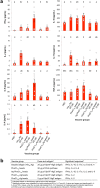Bioengineering a bacterial pathogen to assemble its own particulate vaccine capable of inducing cellular immunity
- PMID: 28150705
- PMCID: PMC5288705
- DOI: 10.1038/srep41607
Bioengineering a bacterial pathogen to assemble its own particulate vaccine capable of inducing cellular immunity
Abstract
Many bacterial pathogens naturally form cellular inclusions. Here the immunogenicity of polyhydroxyalkanoate (PHA) inclusions and their use as particulate vaccines delivering a range of host derived antigens was assessed. Our study showed that PHA inclusions of pathogenic Pseudomonas aeruginosa are immunogenic mediating a specific cell-mediated immune response. Protein engineering of the PHA inclusion forming enzyme by translational fusion of epitopes from vaccine candidates outer membrane proteins OprI, OprF, and AlgE mediated self-assembly of PHA inclusions coated by these selected antigens. Mice vaccinated with isolated PHA inclusions produced a Th1 type immune response characterized by antigen-specific production of IFN-γ and IgG2c isotype antibodies. This cell-mediated immune response was found to be associated with the production of functional antibodies reacting with cells of various P. aeruginosa strains as well as facilitating opsonophagocytic killing. This study showed that cellular inclusions of pathogenic bacteria are immunogenic and can be engineered to display selected antigens suitable to serve as particulate subunit vaccines against infectious diseases.
Conflict of interest statement
B.H.A.R. is founding inventor and shareholder of PolyBatics Ltd.
Figures







Similar articles
-
A Pseudomonas aeruginosa-Derived Particulate Vaccine Protects against P. aeruginosa Infection.Vaccines (Basel). 2021 Jul 20;9(7):803. doi: 10.3390/vaccines9070803. Vaccines (Basel). 2021. PMID: 34358220 Free PMC article.
-
Immunization with outer membrane proteins (OprF and OprI) and flagellin B protects mice from pulmonary infection with mucoid and nonmucoid Pseudomonas aeruginosa.J Microbiol Immunol Infect. 2018 Jun;51(3):312-320. doi: 10.1016/j.jmii.2016.08.014. Epub 2017 Feb 20. J Microbiol Immunol Infect. 2018. PMID: 28291719
-
Outer membrane proteins of Pseudomonas aeruginosa as vaccine candidates.Behring Inst Mitt. 1994 Dec;(95):85-96. Behring Inst Mitt. 1994. PMID: 7538752
-
[Methodological approaches to designing chemical vaccines against bacterial infections].Zh Mikrobiol Epidemiol Immunobiol. 1984 Aug;(8):3-8. Zh Mikrobiol Epidemiol Immunobiol. 1984. PMID: 6207689 Review. Russian. No abstract available.
-
Antibody-mediated immunomodulation: a strategy to improve host responses against microbial antigens.Infect Immun. 2005 Feb;73(2):671-8. doi: 10.1128/IAI.73.2.671-678.2005. Infect Immun. 2005. PMID: 15664904 Free PMC article. Review. No abstract available.
Cited by
-
Mycobacterium avium subsp. paratuberculosis antigens induce cellular immune responses in cattle without causing reactivity to tuberculin in the tuberculosis skin test.Front Immunol. 2023 Jan 18;13:1087015. doi: 10.3389/fimmu.2022.1087015. eCollection 2022. Front Immunol. 2023. PMID: 36741398 Free PMC article.
-
A Polyhydroxyalkanoates-Based Carrier Platform of Bioactive Substances for Therapeutic Applications.Front Bioeng Biotechnol. 2022 Jan 5;9:798724. doi: 10.3389/fbioe.2021.798724. eCollection 2021. Front Bioeng Biotechnol. 2022. PMID: 35071207 Free PMC article. Review.
-
Recent advances in therapeutic targets identification and development of treatment strategies towards Pseudomonas aeruginosa infections.BMC Microbiol. 2023 Mar 30;23(1):86. doi: 10.1186/s12866-023-02832-x. BMC Microbiol. 2023. PMID: 36991325 Free PMC article. Review.
-
Precision-engineering of subunit vaccine particles for prevention of infectious diseases.Front Immunol. 2023 Feb 3;14:1131057. doi: 10.3389/fimmu.2023.1131057. eCollection 2023. Front Immunol. 2023. PMID: 36817419 Free PMC article. Review.
-
Pseudomonas aeruginosa Vaccine Development: Lessons, Challenges, and Future Innovations.Int J Mol Sci. 2025 Feb 25;26(5):2012. doi: 10.3390/ijms26052012. Int J Mol Sci. 2025. PMID: 40076637 Free PMC article. Review.
References
-
- Draper J. et al.. Polyhydroxyalkanoate inclusions: polymer synthesis, self-assembly and display technology. In: Bionanotechnology: biological self assembly and its applications (ed^(eds Rehm B. H. A.) Caister Academic Press (2013).
-
- Foged C. Subunit vaccines of the future: the need for safe, customized and optimized particulate delivery systems. Therapeutic delivery 2, 1057–1077 (2011). - PubMed
-
- Leleux J. & Roy K. Micro and nanoparticle‐based delivery systems for vaccine immunotherapy: an immunological and materials perspective. Advanced healthcare materials 2, 72–94 (2013). - PubMed
Publication types
MeSH terms
Substances
LinkOut - more resources
Full Text Sources
Other Literature Sources
Medical

